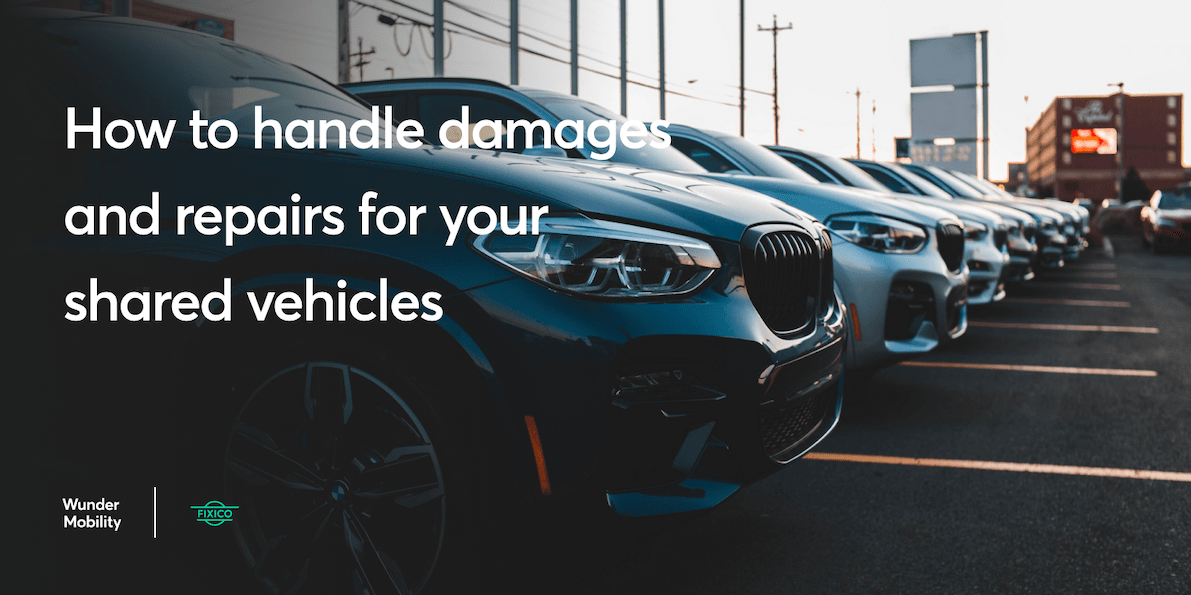Nowadays vehicle sharing is a pervasive part of the transportation landscape. But that doesn’t exclude it from accidents and damage. In fact, next to regular wear and tear, damages can add an additional headache for vehicle sharing operators, especially when it comes to the administration related to reporting and repair.
In this article, you’ll learn from our Marketplace Partner Fixico how you can best manage damages to your vehicle fleet, with a special focus on the benefits of a digital damage management system and how that boosts both driver/rider satisfaction and your business’ operational efficiency.
Vehicle sharing damages and accidents
Currently, vehicle sharing as a service is most common in dense urban areas. Narrow streets, tight parking spaces and busy roads are some of the natural obstacles drivers have to deal with. Any regular driver can tell you that dents or scratches are often, sadly, par for the course.
This is also true for shared vehicles. As Fixico has observed from working with car sharing clients like ShareNow, MyWheels and more, small damages occur very easily. An added complication is that renters are unfamiliar with the vehicle they are driving, which might increase the risk of an accident.
On top of that, repairs for newer models like electric vehicles aren’t as straightforward and may require specialized handling.
Handling damage and repair management for shared vehicles
Regardless if you own a car or rent a sharing vehicle, it’s safe to say that damage will occur at some point in the vehicle’s lifecycle. And these will need to be addressed.
Traditional damage reporting is time consuming and tedious
Traditional damage reporting for rental cars or even just booking maintenance for your privately owned car is time consuming and tedious. Once the damage is discovered and reported, the vehicle sharing company has to arrange the repair by calling up repair shops from their network or the local area, then have the car taken over for a physical inspection to get the damage assessed. Only then will they receive a quote – without having a clear way of knowing if it’s a fair price or not. Once the company accepts the price, the car will have to be taken back to the shop for the actual repair. And once the car is in repair, the company doesn’t receive notifications in real-time – they have to call or email the repair shop to get updates.
Streamlining repair with a digital solution
The challenges of manual communication and lack of transparent processes and pricing can be solved with a digital damage management and repair solution such as Fixico.
One of the key benefits of a digital damage and repair management system is that it removes non-value-added activities. With the help of AI, damage inspection can now be done entirely through images of the damage or affected area. Fixico’s data shows that in the past year, 87% of all damage reports submitted to its platform were assessed entirely digitally. You can only imagine how much time this saves in the damage management process, thereby reducing the vehicle’s overall downtime.
With Fixico’s digital platform, vehicle sharing companies are also able to select the most suitable repairer as quickly as possible. By entering important criteria such as price, duration, distance, and earliest availability, they can choose the body repair shop that fits the vehicle’s specifics and aligns with the business priorities.
Damage management and revenue goals
The transparency that Fixico’s digital management platform gives to the repair process positively impacts a vehicle sharing company’s bottom line.
Repair requests submitted to Fixico can be tendered in a marketplace environment, where suitable repairers can compete for business by offering quotes, or steered directly towards a specific repairer that can address the company’s needs. As a result, vehicle sharing companies can choose the most time and cost effective solution for their business. Last year, Fixico’s repair solution enabled their partners to reduce repair costs by 29% and cycle times by 33% on average.
The future of vehicle sharing repair management
The era of hyper personalization and tailoring services to individuals has also affected the vehicle market. As cars are getting more complex, with a variety of advanced driver assistance systems (ADAS), lightweight materials and electric propulsion, their repair needs are getting more complex as well. A one-size-fits-all approach to damage and repair no longer suffices.
An individual repair handling approach like the one offered by Fixico’s customizable solution helps consider the requirements of each damage, which can be matched up with the capabilities of repairers to find the optimal solution, thereby streamlining the repair journey for all stakeholders.
You can learn more about Fixico and how they can simplify your damage reporting by visiting the Wunder Marketplace.
If you’re curious to know more about fleet safety, specifically about securing your vehicles from fraud and theft, check out the first article in the series.
